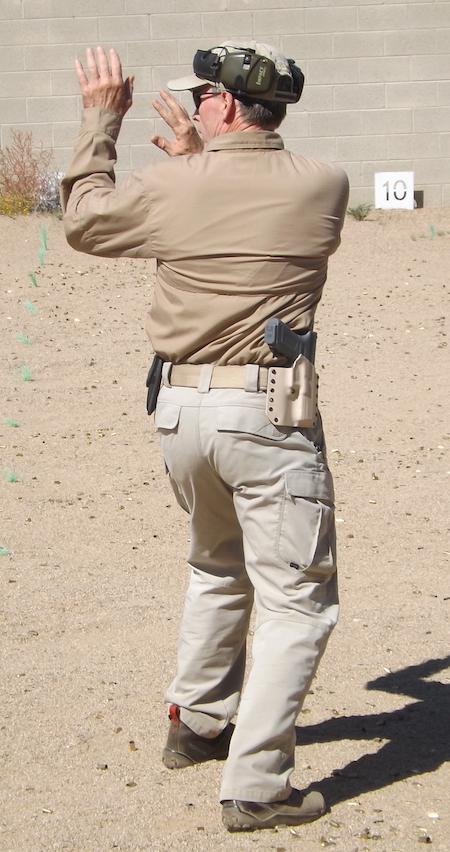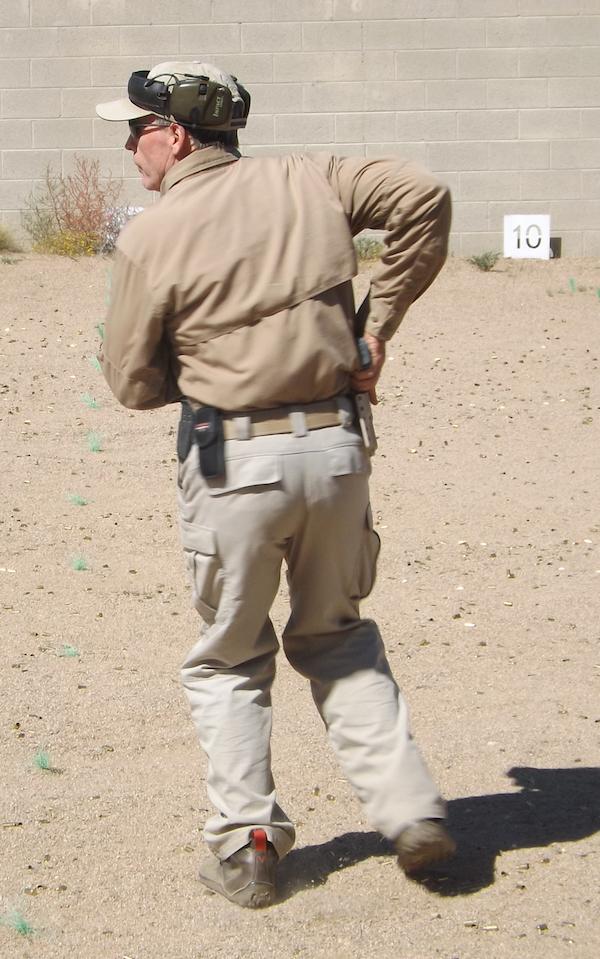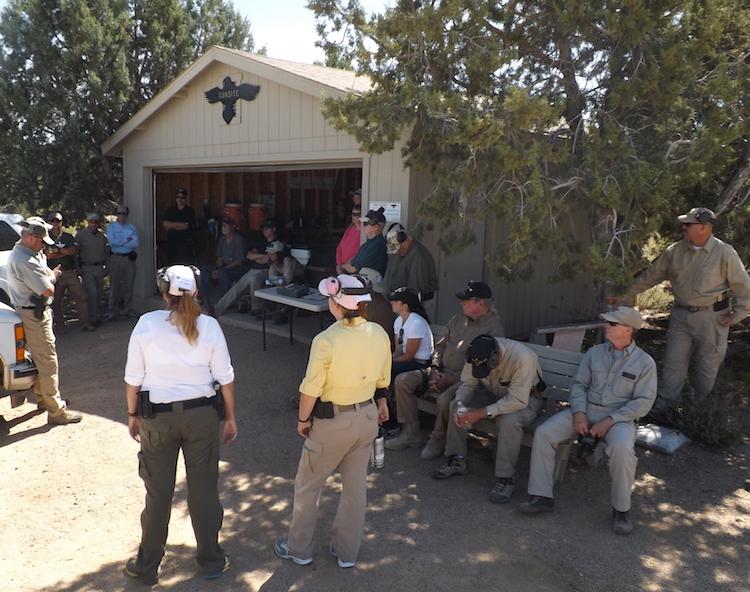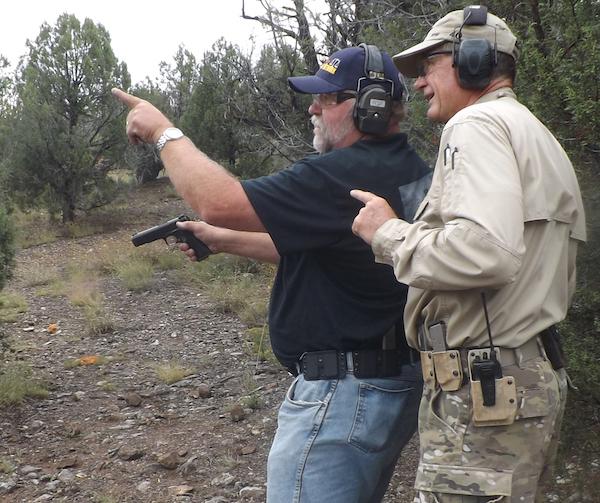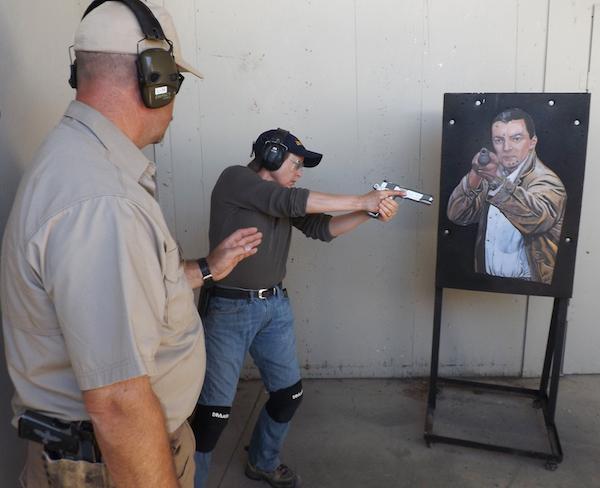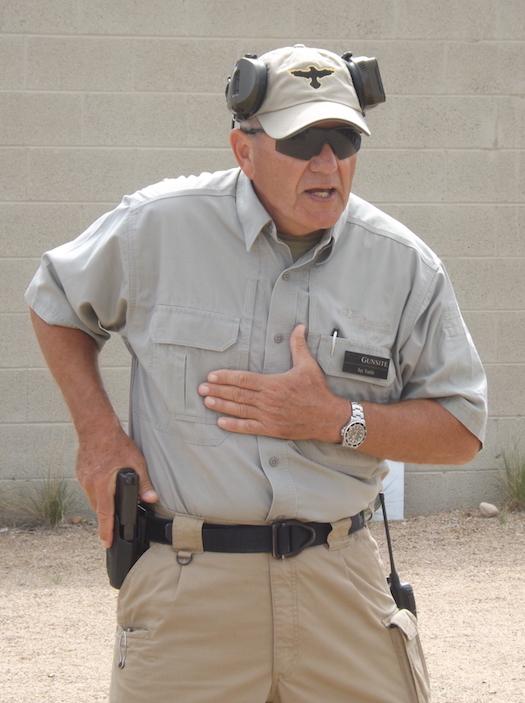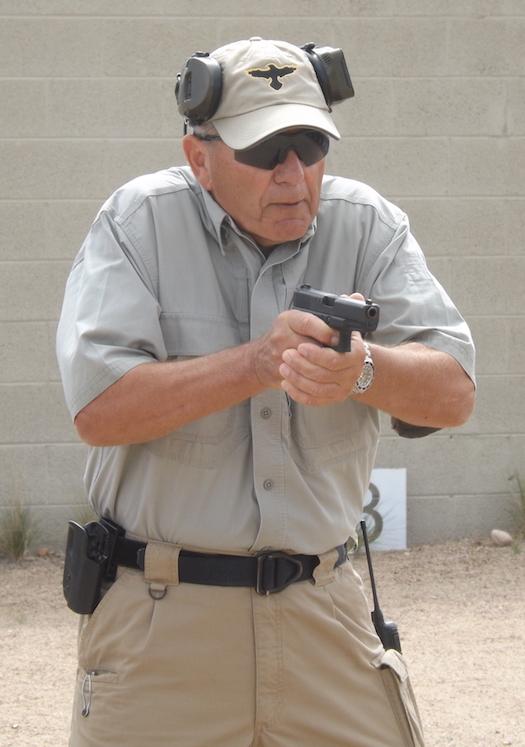by Marty Hayes, J.D.
During the signing of the Declaration of Independence, Founding Father Benjamin Franklin commented, “We must, indeed, all hang together, or most assuredly we shall hang separately,” calling for the 13 colonies to join together and fight for independence. As I begin this article about recently attending Gunsite Academy and becoming a “family member,” I am reminded of Dr. Franklin’s message, and why becoming a Gunsite family member might just be more beneficial than simply taking a training class. You see, the training in small arms use one receives at Gunsite is but one of the takeaways when a person graduates from one of the courses offered.
I became an official Gunsite family member when I attended the Gunsite 250 defensive pistol class last year, and then this year I accompanied four of my fellow Firearms Academy of Seattle instructors back to the ranch to complete the Gunsite 350 intermediate pistol course, and attend the Gunsite Alumni Shoot.
This article details what my staff and I learned and experienced during these two trips, while viewing my experiences through the mission of education and preparation embraced by the Armed Citizens’ Legal Defense Network. (In the above photo, the author waits his turn at an outdoor simulator at Gunsite.)
Handgun Training
I have been a full-time trainer since 1988, first for two and a half years at an indoor gun range in the Seattle area, after which I started my own school, The Firearms Academy of Seattle in 1990. Even before that, I was a police officer and law enforcement firearms instructor, and I was a competition shooter. In other words, I have more than a little experience with firearms and firearms training. Because I own and operate my own shooting range and school, why would I bother spending the (not inconsiderable) amount of money to travel for a week to two weeks at a time to do a bunch of stuff I already know how to do?
Well, first off, did I also mention above that I am over 60? That means that my physical skills are deteriorating as I age. So, in order to keep the skills I do have at their highest levels, I need to train…and train on the fundamentals. Spending a week practicing the draw stroke, speed and tactical reloads, malfunction clearing, weak- and strong-handed shooting, along with use of cover, kneeling and prone was just what this old body needed to re-gain the speed and accuracy that I had sensed was waning. As an instructor, while I do demonstrations in front of class (as does the Gunsite instructional crew), I rarely get to push myself while teaching. Pushing yourself to perform at the highest level is what exposes weaknesses and allows you to improve. If all one ever does is shoot within their present abilities, they never get any better. (In the photos to the right, Rangemaster John Hutchison demonstrates pivot and draw exercises. Recently, Gunsite updated their curriculum to include the defensive hand position demonstrated.)
Defensive shooting skills have been taught and refined for the masses since around 1950 (in law enforcement circles) and really only since the mid 70s in the civilian sector. Looking at the history of the world, that certainly is not a long time, but the evolution of defensive handgunning has pretty much peaked. After all, one can only draw a handgun so fast, perform a reload so fast, and shoot a handgun only so accurately. Gunsite has been at the forefront of this evolution since Jeff Cooper founded the American Pistol Institute in 1976. The name was later changed to Gunsite, to reflect the expansion into teaching the use of shotguns and rifles.
Students attending Gunsite receive cutting edge instruction that actually has been around and tested for decades. These days, advances in the art of defensive handgunning are more heavily focused in the area of tactics, not physical shooting skills. Having said that, like many, I have differing opinions about some of the handgun shooting techniques taught, as in, for example, gripping the handgun. Gunsite teaches students to position their shooting thumb on top of the safety on a 1911 handgun in order to prevent the thumb safety from being inadvertently knocked on while shooting. For a number of reasons, that method does not work as well for me as my old-school revolver grip, where I grip the handgun as hard as I can and wrap my shooting hand thumb around and towards my middle finger, then lock it down with my non-shooting hand thumb.
Although the instructional staff kept on me throughout the week of my recent 350 class, I simply chose to ignore that request and shoot the way I have conditioned myself to shoot for 30 years and through shooting hundreds of thousands of rounds. Of course, the other side of that argument is that if you paid all that money to come to school and then ignore the instructors’ advice, you are foolish, or at least wasting your tuition. I would almost agree, except that last year when I attended Gunsite 250, I did train their way, shooting close to a thousand rounds (left handed) with my thumb on the safety.
I have also trained with other instructors–notably Chuck Taylor, one of Cooper’s original instructors, who helped define the Gunsite doctrine–who also tried to get me to ride the safety, and I always return to the locked thumbs approach. In any case, I didn’t go to Gunsite 350 to learn to shoot, but instead, to hone my own skills, under the coaching and range drills. This flexibility is representative of how Gunsite has changed for the better over past years; they are more tolerant of differing shooting styles. As long as the student is safe and shooting well, they will let him or her continue. Good for them.
I don’t know anyone who is a perfect shooter, and everyone can improve their skills, so any good shooter, or even a great shooter, and especially any instructor can benefit by taking Gunsite’s 250 or 350 classes. In both classes I used the opportunity to perfect the fundamentals we were working on. For each draw, each trigger pull and each reload, I tried it perfectly, and as a result, I came away a better shooter.
The Mental Game
Cooper defined the Combat Triad of defense shooting as composed of three elements: accuracy, gun handling and mindset. For the most part, accuracy and gun handling are drilled in square range training, but like the Triad, the Gunsite experience is not all about shooting drills. Between shooting exercises, the instructional staff presented mini-lectures, covering different aspects of the mental aspects of defensive handgunning. These lectures (as seen in the photo to the left) were well received and were needed, frankly, because of the physical nature of the classes. In my Gunsite 250 experience, it got pretty warm and if we had been required to spend the entire day out standing in the sun, this old guy would have had a problem with the heat. By being allowed to take water or Gatorade (supplied by Gunsite) and sit in the shade during breaks, the class wasn’t unpleasant at all.
My Gunsite 250 and 350 experience adds up to a total of 10 days of training throughout which I found the staff always positive and encouraging, but also tough and demanding. Tough in that they didn’t coddle students, and demanding about safety. As one who runs his own shooting school and who believes in gun control of the sort of which Clint Eastwood quipped, “If there is a gun around, I want to control it,” I was comfortable in the classes and felt the safety protocols were excellent. After the first few hours of day one, we went to a hot range (students’ guns stay loaded), and stayed hot thereafter.
Gunsite is famous for its simulators. I will explain for those who are unfamiliar with the term “simulator.” Like a jet fighter pilot training to survive a dog fight, or a commercial jet pilot training to survive a catastrophic failure of the airplane, the term simulator in the context of defensive handgunning is meant to place the student in a simulated life or death situation where the student works out the logistics and tactics of how to survive. The concept is not new, nor was invented at Gunsite. I have seen early black and white movies of OSS agents being trained in simulations, and, of course, there is the legendary “Hogan’s Alley” of FBI fame. Read more about this interesting history at https://en.wikipedia.org/wiki/Hogan%27s_Alley_(FBI).
Left: Author at the North Draw, working with Rangemaster Walt Wilkinson identifying and shooting long range targets. The conversation is going something like, “Is that a target?”
Right: Gila Hayes negotiates one of the indoor simulators, under the watchful eye and coaching of Rangemaster John Hall. She has already neutralized the target (right) that is armed with the shotgun.
Early in Gunsite’s history, Col. Cooper built two house-clearing simulators, which he named the “Fun House” and the “Play House.” Those original structures are now gone, replaced with state-of-the-art buildings by Action Target, one of the many renovations and improvements instituted by current Gunsite owner Buz Mills. In addition to the live fire building simulators, there are also outdoor simulators, including one named “The Donga.” It replicates moving through an outdoor environment where you might have to search an area, remaining on the lookout for those who might want to kill you. In both Gunsite 250 and 350 the students were put through several exercises both in the shoot houses and the outdoor simulators, under the guidance and coaching of the Gunsite staff.
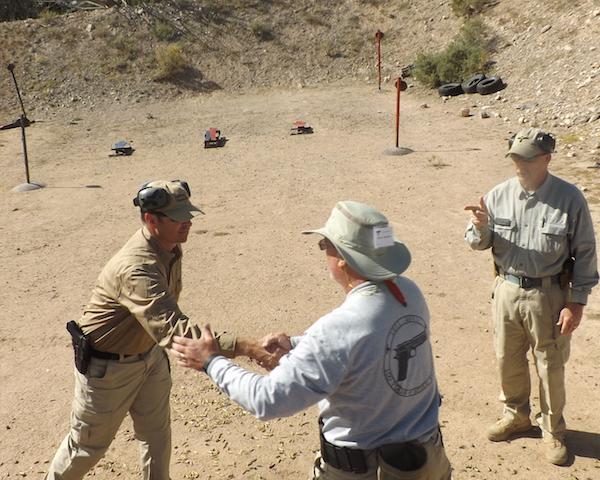
The Gunsite Staff
I am rarely humbled these days when it comes to firearms training and ancillary activities. But I can honestly say that taking the Gunsite 250 and 350 courses from the combined experience of the instructors at Gunsite is a humbling experience.
Each class has one instructor who is in charge and has the title of the Rangemaster. That instructor opens the class in the classroom the first morning, introduces the staff and gives the first morning briefing along with overseeing the staff of additional instructors. The instructor to student ratio is about one to four or one to five, which, if you have taken other commercial training, you know is excellent. Break the class into two relays, and you find a coach behind you and one other student to help you learn the techniques being taught, or in many cases, to help you break old bad habits. Very little goes on in a Gunsite class that isn’t caught by one of the staff members.
Most Gunsite instructors are military veterans, and many completed a second career in law enforcement before joining the staff. Instruction from those with real-world experience is a noticeable deficit among many of the schools that have popped up and are now teaching defensive handgunning. Well, there is no lack of real-world experience among the instructional staff at Gunsite. The privilege of learning shooting techniques and survival tactics from instructors who have earned their bona fides in real world military or law enforcement is the frosting on the cake of the Gunsite experience, and I believe it goes a long way towards imparting the mindset necessary for the mostly civilian students to survive a life-threatening encounter. (Above: Rangemaster Jay Tuttle demonstrates the perfect draw stroke.)
Joining the Gunsite Family
Early on when Gunsite was formed in 1976, Col. Cooper started referring to people who had attended Gunsite as “family members.” Now, I must admit that when I first heard about this from his writings, I found the concept a “little hokey.” I don’t know why I thought that, because at the time I had several years as a police officer under my belt and I understood the concept of the law enforcement family. It was only after I built and operated my own shooting school for a few years, that I realized that my wife and I both considered the students and staff of my own school family members, and thus I came to fully appreciate the concept of the Gunsite family, also called “Ravens.”
What is it like to be a “Raven?” I asked this question of several Network members and staff instructors of The Firearms Academy of Seattle who are “Ravens.” They said–
“Being a Raven means sharing experiences with high quality people who are willing to work hard to hone skills and prepare for danger.” –Gila Hayes
“It made me feel included in something I already was in. They were very welcoming and they understand me and didn’t think I was a total freak. I also felt a sense of accomplishment in getting through both of those classes.” –Diane Walls
“There is a sense of accomplishment with a known standard. Pretty much everybody knows that Gunsite means something. Having someone recognized in the industry evaluate my skill level was valuable, and the connection with like-minded people is a real comfortable feeling.” –Tom Walls

An additional highlight of both my 2015 and 2016 trips to Gunsite was being included in the after-class tour of Jeff Cooper’s home, “The Sconce.”
Although Col. Cooper has left us, passing away September 25, 2006, his widow Janelle Cooper still lives in the Sconce, and on Friday afternoon after the graduation exercises, she invited the class over to her home for a tour. (Left: Gila Hayes pays her respects to Mrs. Cooper.)
Visiting the Sconce is like entering a museum of defensive handgunning. Little else confirms the warm and inclusive feeling of being a Raven like touring the Sconce and sharing brownies and Arnold Palmers (a beverage consisting of iced tea and lemonade, made famous by the late golfer Arnold Palmer) with Mrs. Cooper and her daughters. The tour of the Sconce is not always part of the Gunsite experience, as at times Mrs. Cooper is not available to host. If you are invited, it is a bonus, and one that you will never forget. (Left: The Sconce at sunset, viewed from the Gunsite campground.)
“We must, indeed, all hang together, or most assuredly we shall hang separately.” --Benjamin Franklin
You will recall that I opened this lengthy article with this quote, and I will now explain why. Gun owners share a common experience, and that experience is being part of a culture that a very vocal number of Americans would like to see go away. It is sobering when nearly half of the American population votes for a candidate who singled out gun owners out as her #1 enemy. Gun owners, especially those of us who carry regularly and depend on that ability to protect ourselves and our loved ones, must join together as a single, united, strong voice to thwart any politician or other social construct endeavoring to take away our right to keep and bear arms. The Gunsite family is one such voice, and I personally would like to see that voice grow louder and stronger.
Being a Gunsite family member is one thing that I will cherish throughout the remainder of my lifetime. I recommend Network members pursue training at Gunsite, too, if at all possible.
__________
Gunsite Academy is located outside Paulden, AZ, about 100 miles north of Phoenix, and has a wide variety of courses to increase the student’s skill with pistol, carbine, rifle and shotgun. Learn more at http://www.gunsite.com/.
 The Jeff Cooper Legacy Foundation
The Jeff Cooper Legacy Foundation
Can’t afford a trip to Gunsite? A weeklong course of instruction costs $1,650 in 2016, and while this is not beyond the means of many Network members, I also know that many of our members could not afford the cost of tuition, especially when coupled with the travel expenses. If the latter is the case, especially if you are a firearms instructor, teaching civilian, military or law enforcement personnel and you would like to make the trek to Gunsite, you owe it to yourself to check out The Jeff Cooper Legacy Foundation at http://jeffcooperfoundation.org.
To honor Col. Cooper, Janelle and her daughters Christy and Lindy, started The Jeff Cooper Legacy Foundation in 2008. The purpose of the Foundation is to provide scholarships for people who could not otherwise afford the trip to take a Gunsite Academy 250, and Lindy notes that while their focus is on people who are in positions to pass on what they learn at Gunsite to others, they also have a “a soft spot for first responders who are in positions of responsibility for the safety of others, as well as themselves.” In both of my recent courses, we had a Legacy Foundation student, and the tuition was not wasted on either one of them, as both ended up winning the Friday afternoon shoot-off.
After our experiences at Gunsite, we at the Network felt compelled to do something more than just talk about Gunsite. We have decided to donate a portion of the new membership dues to The Jeff Cooper Legacy Foundation whenever a Gunsite family member joins the Network. Last month we wrote our first check to the Foundation, when several new members told us they are part of the Gunsite family and learned about the Network there.
As word spreads, we anticipate making many more such donations and look forward to supporting this great Foundation for years to come. New members need only tell us that they learned about the Network at Gunsite and we’ll make a donation to The Jeff Cooper Legacy Foundation.
Click here to return to our December 2016 Journal to read more.


